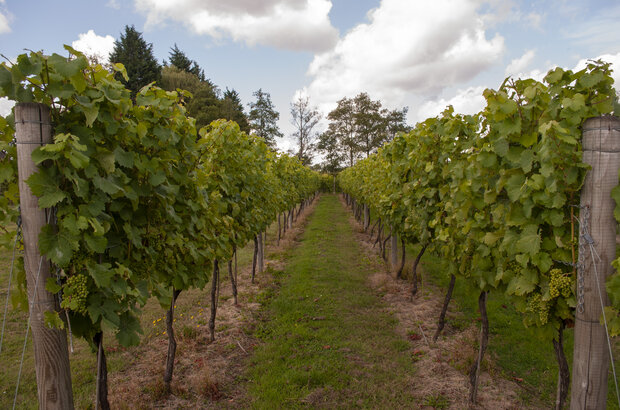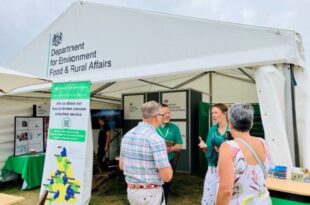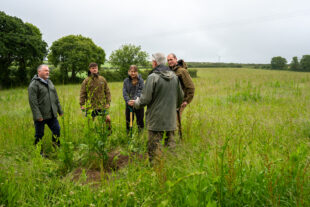
At the beginning of the month, we published a post which summarised the recent Agricultural Transition Plan update. The update includes the full range of new and improved actions plus the payment rates available this year.
Following the update, we said we'd set out the new offer for each farm type in a series of posts. The focus of this post is the offer for arable and horticultural farmers.
We’ll publish a post giving a full overview of the current offer for horticultural farmers tomorrow, so subscribe to the Farming blog for a notification as soon as it’s live.
An offer that works for you
You can apply for an SFI agreement now and choose from the 23 actions on offer. By waiting for the new actions coming in summer, you could be losing out on funding. If you apply now, you'll be able to add actions to your agreement annually — or have multiple agreements when the further actions are available — if you'd like to carry out further actions.
We have a strong existing offer for the arable and horticulture sector across our environmental land management schemes. We have strengthened this by increasing the choice available and improving existing actions. This includes the brand-new actions we are introducing on precision farming and for soil. These will be available in the combined Sustainable Farming Incentive (SFI) and Countryside Stewardship offer.
A recap on the combined offer: we currently have separate SFI and CS Mid and Higher Tier schemes which offer different types of actions and agreements. We plan to offer most SFI and CS Mid Tier actions through a single application service in 2024, rather than having separate application windows and processes. We also plan to remove duplication between SFI and CS Mid Tier actions wherever possible.
New precision farming actions
Precision farming involves using technology to target crop inputs in response to variations within a field.
This can:
- reduce costs and improve yields
- improve productivity
- benefit biodiversity and soil quality
- improve air and water quality
We are introducing 4 new actions to incentivise using precision farming approaches.
By offering payments which support agricultural technology, such as robotic mechanical weeding technology, in addition to launching more grants in 2024 we are helping farmers adopt new technology or practices so they can improve their productivity while benefitting the environment and have more resilient businesses.
When developing the new actions, we discussed the proposals with industry experts, including the Agri-Epi centre, manufacturers, developers and farmers. We also spoke to the major providers of precision farming services/analysis, major agronomy groups and main stakeholders.
More accurate application of fertilisers or manures reduces over-application of nutrients while optimising yield, benefitting water and air quality as well as contributing to net zero targets.
You may also be able to apply for capital items under the Farm Equipment and Technology Fund (FETF) to help you buy precision farming equipment.
The full list of Precision Farming actions
| Action | Duration | Annual payment | Action’s aim |
| Variable rate application of nutrients | 3 years | £27 per hectare (ha) | Variable Rate Application (VRA) technology is used to apply nutrients on arable, horticultural land or improved permanent grassland, to match the nutrient needs of crops in different areas within land parcels |
| Camera or remote sensor guided herbicide spraying | 3 years | £43 per ha | Robotic camera-guided or remote sensing technology is used to precisely target application of systemic herbicides to control weeds on arable land, permanent crops or grassland |
| Robotic mechanical weeding | 3 years | £150 per ha | Robotic mechanical weeding technology is used for precision weed control on arable and horticultural land, reducing or eliminating the use of systemic herbicides |
| Robotic non-mechanical weeding | 3 years | £101 per ha | Robotic non-mechanical weeding technology is used, such as laser or electric weeders, for precision weed control on arable and horticultural land reducing or eliminating the use of systemic herbicides |
New soil actions
The actions for soils are focused on improving soil health, structure, organic matter and biology.
This can:
- improve the long-term productivity and resilience of the soil to benefit food production
- improve water quality
- increase biodiversity
- improve climate resilience
We are improving the existing offer by introducing new actions for no-till farming and multi-species spring/summer and summer/autumn cover crops as below.
The new actions were developed with input from internal and external stakeholders including farmers and agricultural organisations.
| Action | Duration | Annual payment | Action’s aim |
| No-till farming | 3 years | £73 per ha | No-till farming techniques are used to establish crops, so soil disturbance is reduced |
| Multi-species spring/summer and summer/ autumn cover (there will be two offers) | 3 years | £153 to £163 per ha | There is a well-established multi-species cover crop during the spring, summer or autumn months |
In addition to the above soil actions we are also improving our existing offer for protecting lowland peat and adding new actions. We recognise that many farmers face challenges in achieving the existing lowland peat offers for raising water levels, we are introducing new, more accessible options to better enable farmers to raise their water table in their peat soils to more achievable levels.
Webinars: learn more about our offer
- At 11am on Wednesday 31 January, we hosted a webinar specifically about the Improving Farm Productivity grant for horticulture farmers.
Passcode: .a..?V5f
- At 2pm on Monday 12 February, you can learn more about our range of funding support on offer through our farming schemes, Register to attend.
We’ll post the recordings on the blog once they’re over.
You can also take a look at the full list of actions available in the combined Sustainable Farming Incentive (SFI) and Countryside Stewardship (CS) offer in the Technical Annex to the ATP.
Finally, if you have any questions about our work, do leave a comment below.





12 comments
Comment by Will Nixon posted on
Can the no-tail farming option be used on grassland to establish Herbal ley option in the sfi?
Comment by The Team posted on
Hi Will
The payment is for no till and is £73 per ha it isn't an action for direct drilling. It's about adopting no till techniques to establish crops to limit soil disturbance.
Like all other SFI options they are paid per ha so if you want to do no till on 10ha, you would get paid for 10ha. Further details here about the actions and payments for no till can be found here: https://www.gov.uk/government/publications/agricultural-transition-plan-2021-to-2024/technical-annex-the-combined-environmental-land-management-offer#arable-land-grassland-and-permanent-crops
We do have existing capital items that include direct drills and the use of robotic and automated equipment, and systems to aid crop and livestock production here: https://www.gov.uk/guidance/farming-investment-fund#farming-equipment-and-technology-fund-fetf-2023
Hope that helps,
The Team
Comment by Jane Durrant posted on
Whilst I appreciate all the many improvements currently being made to the SFI scheme, one that has not improved is the inability to keep to the payment schedule. I am still waiting for my October 2023 and January 2024 payment, because "the checking process is taking longer than expected". This SHOULD NOT delay payment. Check as much as you like, and if there is an error, correct it, but KEEP to the agreement and pay us on time. Until this happens, we cannot rely on SFI for our cashflow, and the doubters will not be persuaded to join.
Comment by The Team posted on
Hi Jane,
Thanks for sharing your experience - we're sorry there have been delays. We've passed your comment onto the team at the Rural Payments Agency for their attention.
If you'd like to talk to them about your application: https://www.gov.uk/government/publications/contact-the-rpa-about-sfi
Best wishes,
The Team
Comment by Liz Sellers posted on
Will over winter stubbles ( currently a CS Mid tier option) feature in the SFI or streamlining if the SFI and CS mid tier which is going to take place this summer- essentially will we still be able to have over winter stubbles as a paid option in the future?
Comment by The Team posted on
Hi Liz,
The Technical annex sets out the land management actions we will pay for in the combined SFI and CS offer.
If you scroll to section 5B, you'll see the basic and enhanced overwinter stubble actions.
Here's a link to the relevant bit of the annex: https://www.gov.uk/government/publications/agricultural-transition-plan-2021-to-2024/technical-annex-the-combined-environmental-land-management-offer#arable-land-grassland-and-permanent-crops
Best wishes,
The Team
Comment by Mark T posted on
Hi
When will more information be available for The New Actions for 24 such as Variable Rate Fertiliser and No Till Drilling? By information I mean
Info Like
This Actions Aim?
Where Can you do it
What to do?
Where to do it?
How to do it?
Evidence needed?
Thanks
Comment by The Team posted on
Hi Mark,
Thanks for getting in touch, the current guidance for precision farming and no till actions is in this document: https://www.gov.uk/government/publications/agricultural-transition-plan-2021-to-2024/technical-annex-the-combined-environmental-land-management-offer#arable-land-grassland-and-permanent-crops It provides details on payment rates, the actions aims and agreement lengths.
The full guidance will be available ahead of applications opening for the combined offer. For no till action you can get £73 per ha and you can find this in section 1b under improving soil health. Precision farming actions are in Table 4 under Precision farming: https://www.gov.uk/government/publications/agricultural-transition-plan-2021-to-2024/technical-annex-the-combined-environmental-land-management-offer#arable-land-grassland-and-permanent-crops
You can read the full guidance on how to take photos as evidence here: https://www.gov.uk/guidance/how-to-take-photographic-evidence-for-sfi-actions.
Hope that helps,
The Team
Comment by Phillip Maw posted on
Hello
Can I ask if footpath and bridleway access is back for the SFI24 after being removed from HLS a few years ago
Thanks
Comment by Sarah Stewart posted on
Hi Phillip,
This section in the SFI Technical Annex covers access:
https://www.gov.uk/government/publications/agricultural-transition-plan-2021-to-2024/technical-annex-the-combined-environmental-land-management-offer#access-and-engagement
Best wishes,
Sarah
Comment by Simon Gadd posted on
PRF2: Camera or remote sensor guided herbicide spraying
I am interest in the definition of "automatically switches on individual nozzles", does this have to be turning on/off "an" individual or can it be a small group of nozzles. If it can be a small group what is the limit?
The remote sensing, can the applicable maps be created by drone or satellite?
Kind regards,
Simon Gadd
Comment by The Team posted on
Hi Simon,
It is individual nozzle control. Remote sensing can be by drone but it's hard for satellite to detect individual weeds (satellite can do the remote sensing for PRF1 VRA nutrient application though)
Best wishes,
The Team